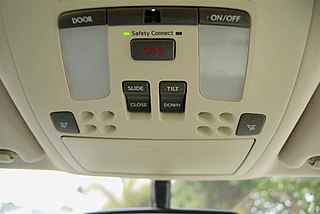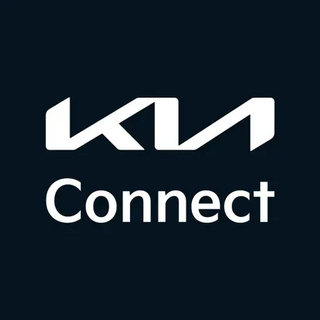An over-the-air update, also known as over-the-air programming, is an update to an embedded system that is delivered through a wireless network, such as Wi-Fi or a cellular network. These embedded systems include mobile phones, tablets, set-top boxes, cars and telecommunications equipment. OTA updates for cars and internet of things devices can also be called firmware over-the-air (FOTA). Various components may be updated OTA, including the device's operating system, applications, configuration settings, or parameters like encryption keys.

Telematics is an interdisciplinary field encompassing telecommunications, vehicular technologies, electrical engineering, and computer science. Telematics can involve any of the following:

OnStar Corporation is a subsidiary of General Motors that provides subscription-based communications, in-vehicle security, emergency services, turn-by-turn navigation, and remote diagnostics systems throughout the United States, Canada, Chile, China, Mexico, Europe, Brazil, Colombia, Argentina and the Gulf Cooperation Council countries.

Body-on-frame is a traditional motor vehicle construction method whereby a separate body or coach is mounted on a strong and relatively rigid vehicle frame or chassis that carries the powertrain and to which the wheels and their suspension, brakes, and steering are mounted. Whereas this was the original method of building automobiles, body-on-frame construction is now used mainly for pickup trucks, large SUVs, and heavy trucks.

On-board diagnostics (OBD) is a term referring to a vehicle's self-diagnostic and reporting capability. In the United States, this capability is a requirement to comply with federal emissions standards to detect failures that may increase the vehicle tailpipe emissions to more than 150% of the standard to which it was originally certified.

Automatic parking is an autonomous car-maneuvering system that moves a vehicle from a traffic lane into a parking spot to perform parallel, perpendicular, or angle parking. The automatic parking system aims to enhance the comfort and safety of driving in constrained environments where much attention and experience is required to steer the car. The parking maneuver is achieved by means of coordinated control of the steering angle and speed which takes into account the actual situation in the environment to ensure collision-free motion within the available space.
A Vehicular ad hoc network (VANET) is a proposed type of mobile ad hoc network (MANET) involving road vehicles. VANETs were first proposed in 2001 as "car-to-car ad-hoc mobile communication and networking" applications, where networks could be formed and information could be relayed among cars. It has been shown that vehicle-to-vehicle and vehicle-to-roadside communications architectures could co-exist in VANETs to provide road safety, navigation, and other roadside services. VANETs could be a key part of the intelligent transportation systems (ITS) framework. Sometimes, VANETs are referred to as Intelligent Transportation Networks. They could evolve into a broader "Internet of vehicles". which itself could evolve into an "Internet of autonomous vehicles".

BMW Assist is a telematic roadside assistance service offered by BMW. BMW Assist is similar to GM's OnStar or Mercedes-Benz mbrace services as they both use the cellular network and Global Positioning telemetry to locate or guide the vehicle. BMW Assist can provide turn-by-turn directions, remote unlocking, vehicle diagnostics, airbag deployment notification, theft recovery and towing or flat tire repair. The service is included free in most new BMWs. After expiration, it can be purchased at a yearly rate. As of March, 2016, BMW assist is undergoing a "technology upgrade" in the US, and renewals are not being processed for MY2013 and older models. BMW has provided no estimated time for completion. Those whose memberships have expired no longer have the advantages of the Safety or Convenience plans. Members who have active service as of December 31, 2016 will have a choice to receive $200 compensation for losing service or to receive a hardware retrofit to continue service. There is a population for whom BMW did not allow renewal between March and December 2016, thus forcing them out of safety and security features.

In-car entertainment (ICE), or in-vehicle infotainment (IVI), is a collection of hardware and software in automobiles that provides audio or video entertainment. In car entertainment originated with car audio systems that consisted of radios and cassette or CD players, and now includes automotive navigation systems, video players, USB and Bluetooth connectivity, carputers, in-car internet, and WiFi. Once controlled by simple dashboards knobs and dials, ICE systems can include steering wheel audio controls, handsfree voice control, touch-sensitive preset buttons, and even touch screens on higher-end units. Latest models of In-car entertainment systems are coming equipped with rear-view cameras along with side cameras for better safety.

Lexus Link, launched in October 2000, is a subscription-based safety and security service from Lexus. It has been offered as a factory-installed option, available on certain Lexus models, offering call-center-based telematics services to owners with equipped vehicles in the United States and Canada. The second-generation Lexus Link system utilizes a dedicated cellular phone, Global Positioning Satellite (GPS) technology and 24-hour live-operator support. In 2009, an expanded system with added functionality, Lexus Enform with Safety Connect, succeeded Lexus Link.

Safety Connect is a subscription-based telematics system introduced by Toyota Motor Corporation in 2009 for its Toyota-branded and Lexus models. The system provides communications, roadside assistance, car safety, remote diagnostics, and other services. Unlike the earlier Lexus Link service offered on Lexus models, the Safety Connect system is proprietary and not licensed from GM's OnStar service. Safety Connect began to be offered on vehicles in the middle of 2009. For Toyota vehicles, the Safety Connect service is offered including the aforementioned features as part of the Toyota Entune telematics package, while Lexus models receive the Lexus Enform telematics system with Safety Connect, adding hands free calling, and destination assistance services.

G-Book was a telematics subscription service provided by Toyota Motor Corporation in Japan for its Toyota- and Lexus-branded vehicles. G-Book allowed users to link with cellphones. personal digital assistants (PDA)'s, personal computers (PC) and G-Book equipped cars across Japan. It is based on the former GAZOO infrastructure of Toyota's membership-based information service and membership system, and it provides interactive information services via vehicle installed touch-screen wireless communication terminals. It also incorporates information from Toyota Mapmaster Inc. which updates digital mapping information and is used by various international companies.

Kia Connect, formerly UVO eServices, is a paid subscription OEM infotainment and telematics service offered by Kia Motors America on select vehicles for the United States market. The system allows users to make hands-free calls on their smartphone, stream music, navigate to a POI, and perform vehicle diagnostics with the use of voice commands.

Toyota Entune is an integrated multimedia navigation and telematics system for Toyota automobiles that provides satellite-based information on traffic, weather, sports scores, stocks, and fuel prices via subscription through SiriusXM. When connected to a compatible mobile phone running the Entune app via radio or USB cable, the system provides a browser and other apps, including music services such as iHeartRadio, Pandora and XM Satellite Radio. The cell phone app supported iOS, Android, and Blackberry with different versions utilizing cell data. The system could be controlled with (limited) speech recognition, and optionally include the “Safety Connect” personalization system.
A connected car is a car that can communicate bidirectionally with other systems outside of the car. This connectivity can be used to provide services to passengers or to support or enhance self-driving functionality. For safety-critical applications, it is anticipated that cars will also be connected using dedicated short-range communications (DSRC) or cellular radios, operating in the FCC-granted 5.9 GHz band with very low latency.

CarWings, renamed NissanConnect in 2015, and also branded as Infiniti InTouch is a vehicle telematics service offered by the Nissan Motor Company to drivers in Japan, the United States, Canada, Great Britain, and most other countries. It provides mobile connectivity for on-demand traffic information services and internet provided maps displayed inside select Nissan vehicles. The service began in December 1997, and was introduced with the name Compass Link, having been installed in the 1997 Nissan Cedric, Nissan Gloria, Nissan President, Nissan Cima, Nissan Laurel, Nissan Leopard and the Nissan Elgrand. Compass Link was a service provided by Compass Link Co., Ltd. which was also offered to Mitsubishi and BMW vehicles in Japan beginning January 2000.
Autonet Mobile was a Santa Rosa, California based company that provided 4G in-vehicle telematics devices, and marketing and management software for automotive dealerships and aftermarket service providers. The company held several original equipment manufacturer agreements with the automotive manufacturers General Motors, Chrysler, Dodge, Jeep, Subaru, and Volkswagen. In early 2011, it was estimated that there were 10,000 Autonet Mobile users in the United States. As of 2009, the Autonet Mobile routers were primarily available as a factory installed product that required activation, although they were also available as an aftermarket product through auto dealerships and retailers as well as online retailers like Amazon.com.
Cellport Systems, Inc., is an American company specializing in the invention, prototype development, patenting, and licensing of wireless connectivity technologies for Internet-connected vehicles and mobile devices. Cellport also develops vehicle gateways using secure blockchain technology. Cellport licenses its technologies to vehicle and wireless device manufacturers worldwide.
Automotive hacking is the exploitation of vulnerabilities within the software, hardware, and communication systems of automobiles.

Hum is a vehicle diagnostic and tracking system from Verizon Communications. The system is composed of two devices: a diagnostics reader which connects to a vehicle's OBDII and a speaker with Bluetooth connectivity that can be clipped to the visor. A monthly subscription is required, but also includes a mobile application for reviewing collected data and receiving alerts as well as roadside assistance. The Hum was first revealed in January 2015 under the name Verizon Vehicle, but was rebranded before its release in August of that year.












